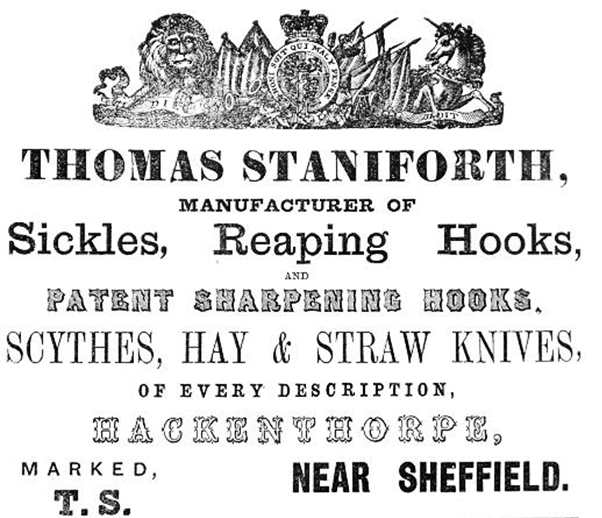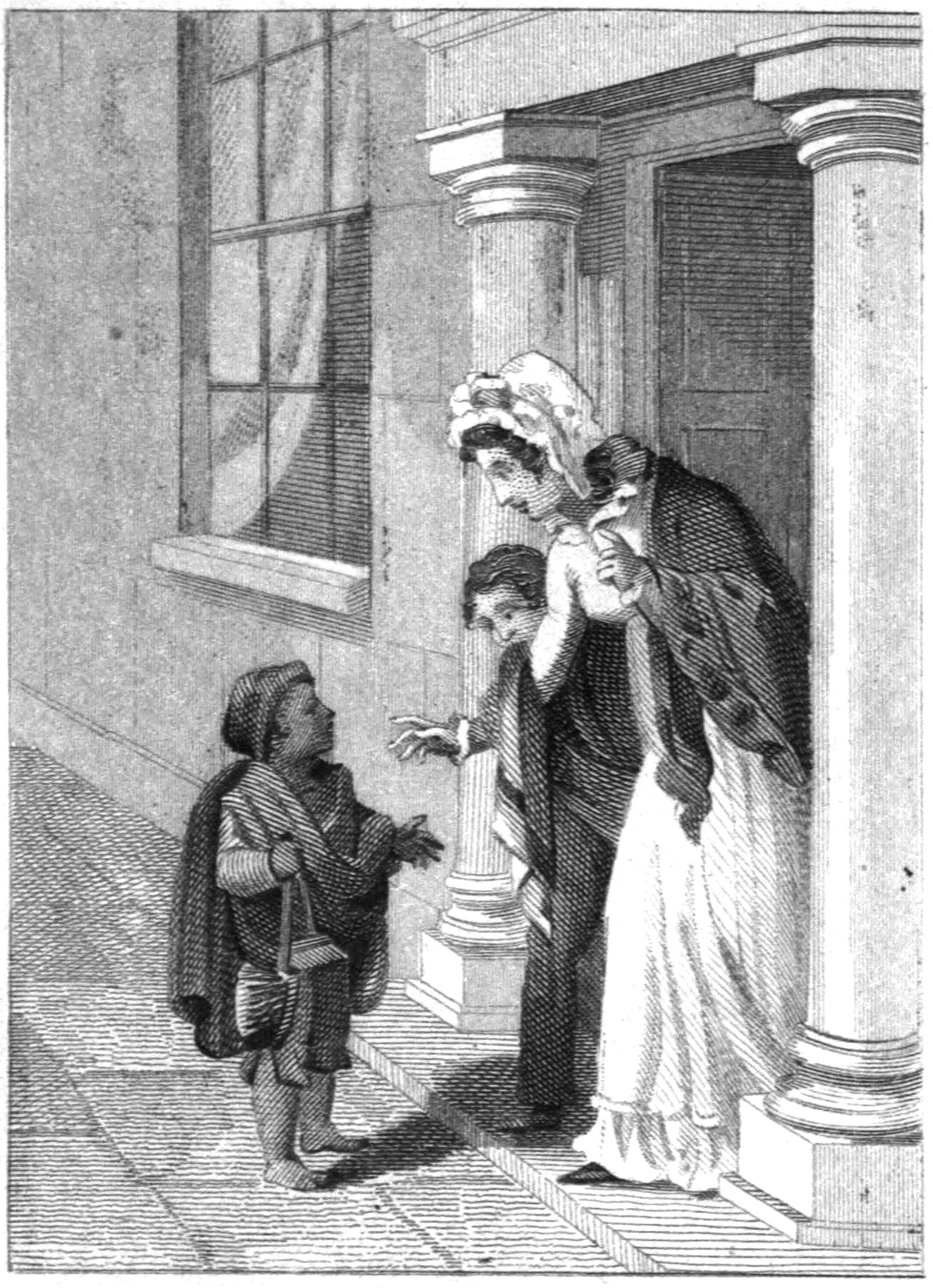
Thomas Staniforth & Co. Sickle works at Hackenthorpe.
 'The Little Chimney Sweep, Unknown artist, 1828
'The Little Chimney Sweep, Unknown artist, 1828
Paul Staniforth was baptised on February 20th, 1814 in Millthorpe, Derbyshire. His parents William Staniforth and Ann Rushton married at Eyam on the 25th June 1805.
Paul Marries Mary Younge 24th March 1834 at Sheffield St Peter & St Paul, and on the 1841 Census we see Paul living with his wife and daughter Elizabeth Staniforth. He is described a Chimney Sweep. Mary Younge passes away early into the marriage in 1854.
On the 1851 Census, Mary is living at Portobello Street with daughters Elizabeth and Mary Ann and a son William, however Paul is absent, he is found on a seperate census in Wakefield Prison. Here Paul, a chimney sweeper, describes his birthplace as 'Totley, Derbyshire'
On an 1852 Directory of Sheffield, Paul Staniforth is listed as a Chimneysweep at Portobello Road.
Paul then Marries Mary Wright on the 24th of December, 1854, their marriage was announced in the Sheffield Independent on December 30th, at this time they are both described as being of 'Portobello Street' and the marriage occured at the Norfolk Street chapel.
In the Sheffield Independent dated Saturday 25th January 1851, we find the following story:
'Prosecution of a Chimney-sweep - Paul Staniforth, a sweep in the employ of Mr. Aitchison?, of the Wicker, was charged under the "Climbing Boys' Act" with unlawful sending his own son, a boy seven years of age, up a chimney. Mr. Broomhead appeared for the defense. A fortnight ago, Mr Aitchison having received information that Staniforth was sending his own child up chimneys instructed the foreman to watch him, and the result was that the information was confirmed. Mr. Aitchison then spoke to Staniforth on the subject, and he replied that he would learn the boy to sweep chimneys in spite of anything Mr. Aitchison might say. Means were then taken to secure the establishing of a charge against the defendant, and the present proceedings were the result. It was proved that on the morning of Friday week, a young man named Barker and the child went to the house of a gentleman named Hinchliffe, followed by Staniforth who ordered his child to take off his boots, and then put him up the chimney. He had a machine with him, which he ought to have used, but did not. He told his child that it was a nice chimney to go up, and if he framed well about it he would give him a penny. When the child got to a bend in the chimney he called out "Father, there's a bend here, what must I do?" Staniforth replied "Oh, you must try and work yourself through on your hands and knees." The boy got past the bend, and Staniforth sent Barker up after him to the top of the chimney. The defence was, that the boy was put up the chimney by Barker before Staniforth reached the house, and on learning the fact he sent Barker up to fetch him down. He also imputed that this was a revengeful proceeding on the part of Mr. Aitchinson, whom he charged with being regularly in the habit of employing youths under the age fixed by the act, to ascend chimneys.... Mr. Aichison denied these statements... Mr. Broomhead stated, that at Manchester and other places the sweeping of chimneys by boys was permitted without any prosecution being taken.... Mr Aitchinson: And only a fortnight ago a boy was burnt to death in a Chimney at Manchester.... Mr. Brown said, the case was clearly proved and convicted the defendant in the penalty of £5 or two months imprisonment in default of payment.'
It seems however Paul did not learn his lesson, as another story appears in the newspaper dated Saturday 23 June 1855:
'Charge Against a Chimney Sweep - Paul Staniforth of Portobello Street, was charged with allowing his son, aged 12 years, to ascend the chimney of W. Butcher, Esq. of the Five Oaks, Glossop Road. Mr. Fretson appeared in support of the charge, and Mr. A.C Branson for the defence. The information was laid under the act passed mainly through the exersions of the late Mr. S Roberts and Mr. Montgomery, which imposes very heavy penalties on any person who either sends or permits any one under 21 years of age to ascend a chimney for the purpose of sweeping it. The information was laid by Abel Haywood of Bee Hive lane, sweep, along with another sweep named Charles Fox, who gave evidence in support. their statement was that about ten o'clock on Wednesday morning, Fox was near the top of Wilkinson Street, when he saw Staniforth and his son going up the Glossop road, having no machine with them. Along with Haywood, he watched them into the house of Mr. Butcher. They entered the grounds in front of Mr. Butcher's house, and he shortly saw the hand of a boy, with a brush, projecting from one of the chimneys. Fox went to the entrance hall, where he met Mrs. Butcher. He asked "Is the sweeps here?" and Mrs. Butcher replied "He is in that room." He entered the breakfast room, which was pointed out, and there found Staniforth on one knee, holding the cloth to the fireplace , to catch the soot. Staniforth had no machine in the room, and called to his boy to "Look sharp and come down." He intimated to Staniforth that he had now caught him at what he had long been watching for, and turning to the maid servant who was in the room, called upon her to witness that a boy was up the chimney. She made no answer, but went out and sent in the cook, who demanded his authority for coming into the house. He said to her "You see the boy is up the chimney?" but the only answer she made, was to order him out of the house. When Fox came out, he called to Haywood "There's the boy up the chimney now." Mrs. Butcher who was walking in the grounds in front of the house asked "Are you two spies?" and Haywood replied "We are spies, so far as we spied a boy up the chimney, and that's all we wanted." Haywood then went round to watch at the back of Mr. Butcher's house for Staniforth and his son leaving, while Fox watched in front. Fox declared that Staniforth fetched a sweeping machine from a gentleman's residence in Clarkhouse lane, to Mr. Butcher's . Haywood while watching at the back of the house, alleged that he saw Staniforth's boy come to the gate, and on seeing him, hastilly retreated into the house and "Looked as he would have crept into a mouse hole." and that he (Haywood) called out "Billy, it's no use going back for you are fairly caught, and your father will have to pay for it." in cross examination, Fox said he believed at the time he was at the house that Mr. Butcher was a magistrate.... Mr. A. Smith remarked that it was Mr. Butcher;s brother who was a magistrate... Mr. Branson said he should prove, that not only was the chimney swept by machine but that the boy had left the house before Fox entered. He imputed that the motive for trumping up this charge was to be seen in the fact that there was some strong personal feeling against Staniforth and that they were under the impression that the house was that of Mr. S Butcher, who happened to have finey Haywood £5 recently, for putting a boy up the chimney. He called Mary Whittington, cook to Mr. Butcher, who stated most positively that Staniforth brought the machine with him. When she went into the room, Fox said the boy was up the chimney That was not true, for the boy had then elft the house, and Staniforth was using the machine, and had part of it on the hearth as Fox must have seen. When she asked what he was doing there, Fox said Mrs. Butcher had sent him and this she must now know was untruth. The boy was hardly a minute in the room. Staniforth: I had sent him to collect the pay for some other chimneys I had swept...Mr. Fretson proposed to ask the witness whether Mr. Butcher's chimneys were not always swept by a boy?...Mr. Branson objected to the question as the answer might implicate others and under his advice, the witness declined to answer.... Wm. Cottam, groom to Mr. Butcher, proved that the moment Fox left the house he went into the breakfast room, and found Staniforth was using the machine. He stood by while Staniforth drew it from the chimney and took it in pieces. Staniforth's boy had left the house, he (Cottam) having met him in the back lane before Fox entered.... Mr. Fretson suggested that, after sweeping the chimney with the boy, Staniforth went and fetched the machine as a blind, and that it was then, and not when Fox was at the house, that the cook and the groom saw the machine... Both the cook and the groom, however, repeated that they were positive that the machine was there and in use when Fox was in the room -: - The magistrates dismissed the case.
On the 1861 Census, Paul is out of prison and is living with his his wife at Portobello Road once again, this time their only child is daughter Mary Staniforth,
It is unclear what happened to the son William.
Paul dies in 1870, and while he may not have had the most significant job, he certainly provided an interesting story.